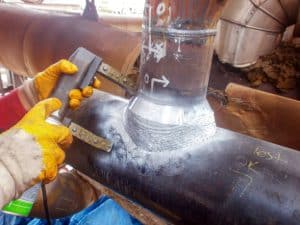Welding is a crucial process in various industries, from construction to aerospace and manufacturing. The strength and integrity of welds are paramount for the safety and performance of structures and products.
To assess the quality of welds without compromising the workpiece, non-destructive weld testing (NDT) methods are employed. In this comprehensive guide, we will delve into various NDT methods, each with its unique advantages and applications, ensuring welds meet stringent quality standards and safety requirements.
What Is Non-Destructive Weld Testing?

Non-destructive weld testing (NDT) is a critical quality control process that assesses the integrity of welded joints without causing any harm to the workpiece. NDT methods provide invaluable insights into weld quality, allowing defects to be identified and addressed while preserving the structural integrity of the welded components.
Non-Destructive Weld Testing Methods
Here are interesting methods for Non-destructive weld testing.
Visual Inspection
Visual inspection is the simplest yet fundamental method in NDT. It involves a thorough examination of welds using the naked eye or aided by optical instruments like magnifying glasses or borescopes.
Visual NDT can detect surface irregularities, such as cracks, porosity, undercut, and incomplete fusion. It is often the first step in weld testing to identify issues that may require further examination using other NDT methods.
Liquid Or Dye Penetrant Inspection
This is an inspection method that determines the existence of discontinuities on the surface of an object by the action of the capillaries. It is known as liquid penetrant testing (PT) or dye penetrant inspection (DPI). A penetrant solution is applied to the surface of the weld, and the excess penetrant is removed.
In the next step, a developer is applied, which draws the penetrant from any surface defects so they can be seen. PT is highly effective for locating cracks, porosity, and other open-surface defects in welds.
Magnetic Particle Inspection
Magnetic particle testing (MT) is primarily used to identify surface and near-surface defects in ferrous materials. The process involves applying a magnetic field to the material and sprinkling iron particles or magnetic ink on the surface.
Any discontinuities or cracks in the weld create magnetic flux leakage, causing the particles to gather at these locations. MT is a fast and reliable method for detecting surface-breaking defects.
Eddy Current Inspection
Eddy current testing (ET) is suitable for inspecting conductive materials, including various metals. It works based on the principle of electromagnetic induction. A coil generates an alternating current that induces eddy currents in the material under inspection.
Discontinuities in the material disrupt the eddy currents, leading to changes in electrical impedance, which are detected and analyzed. ET is particularly effective for detecting cracks, corrosion, and thickness variations in welds.
Ultrasonic Inspection
Ultrasonic testing (UT) employs high-frequency sound waves to evaluate the internal structure of a weld. A transducer sends ultrasonic waves into the material, and the echoes received are analyzed to determine weld integrity.
UT is excellent for detecting hidden defects such as cracks, inclusions, and voids. Phased array ultrasonic testing, a more advanced form of UT, offers enhanced accuracy and flexibility in inspecting complex weld geometries.
Acoustic Emission Monitoring
Acoustic emission testing (AE) relies on the detection of high-frequency acoustic signals emitted by materials under stress. During welding, the sudden release of energy at the site of a defect generates acoustic emissions.
AE sensors capture these signals, and the data is analyzed to pinpoint the location and severity of the defect. AE is especially useful for monitoring in-service welds and identifying defects that may propagate over time.
Industrial Radiography
Industrial radiography employs X-rays or gamma rays to create a radiographic image of the welded joint. This method can reveal both internal and surface defects in welds.
Radiographs provide detailed information about the size, shape, and location of discontinuities, making it a valuable tool for weld assessment. However, RT involves exposure to ionizing radiation, necessitating strict safety precautions.
Leak Testing
Leak testing (LT) is employed to assess the integrity of welds in pressure vessels or other components that must maintain a gas or liquid-tight seal. It involves pressurizing the component with a gas or liquid and monitoring for any leakage.
LT can be performed using various methods, including pressure decay, bubble testing, and tracer gas detection. It is crucial for ensuring the safety and reliability of welded pressure systems.
Choosing The Right Ndt Method
Selecting the appropriate NDT method for a specific welding application depends on several factors:
- Material: Different NDT methods are better suited for certain materials, so consider the composition of the weld and base material.
- Weld Type: The geometry and type of weld (e.g., fillet, groove, butt) may influence the choice of NDT method.
- Defect Type: Identify the potential defects you need to detect, whether they are surface or subsurface, to determine which NDT method is most suitable.
- Access: Consider the accessibility of the weld joint; some methods may be more challenging to apply in confined spaces.
- Sensitivity: Evaluate the required level of sensitivity to ensure that the chosen NDT method can detect defects of the desired size.
- Cost and Time: Factor in the budget and time constraints for the inspection process, as some methods may be more cost-effective or quicker than others.
Importance Of Non-Destructive Weld Testing
The importance of Non-destructive weld testing (NDT) can be summarized in the following key points:
- NDT ensures the safety of structures and products by identifying defects in welded joints and preventing catastrophic failures.
- It is a vital quality control measure, helping maintain high welding standards and minimizing the risk of subpar welds.
- NDT methods are more cost-effective than destructive testing, as they allow weld assessment without scrapping or damaging the workpiece.
- It detects defects at an early stage, enabling timely repairs and preventing defects from propagating.
- NDT is non-invasive, meaning it doesn't alter or harm the weld, making it ideal for sensitive applications.
- Many industries and regulatory bodies mandate NDT as part of quality assurance and safety compliance.
- By identifying areas of improvement, NDT helps optimize the welding process, reducing rework and waste.
- It contributes to the longevity of structures and components by ensuring welds remain intact over time.
Conclusion
Non-destructive weld testing methods play a vital role in ensuring the quality and safety of welded components in various industries. From visual inspection to advanced techniques like ultrasonic testing and radiography, each NDT method offers unique advantages for detecting different types of defects.
By selecting the appropriate NDT method based on the specific requirements of the welding project, manufacturers can maintain the integrity of their welds and achieve high-quality results while avoiding the need for destructive testing methods that can compromise the workpiece's integrity.
In the world of welding, non-destructive testing is the key to building strong, reliable structures and products that stand the test of time.

